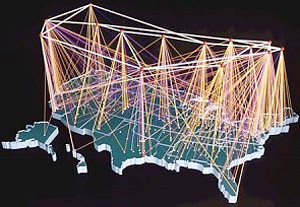Guest Blogger Jessica Bosari
 Smart grid technology is quickly moving from theory to reality in many parts of the United States. The technology consists of a group of new energy delivery techniques based on ideas that started over 100 years ago in the mind of Nikolai Tesla. He saw a world where power was delivered on demand from a centralized power generator, going in both directions so that nothing was wasted.
Smart grid technology is quickly moving from theory to reality in many parts of the United States. The technology consists of a group of new energy delivery techniques based on ideas that started over 100 years ago in the mind of Nikolai Tesla. He saw a world where power was delivered on demand from a centralized power generator, going in both directions so that nothing was wasted.
Much of today’s technology focuses on the way appliances handle energy, like smart appliances that know when to draw power and when not to draw power. Changes to the delivery methods of power from the power stations may take more innovation and time to accomplish. Tomorrow’s technology workers will have to solve problems of efficiency, integration and returning unused energy to the grid.
Grid Needs Multiple Sources and Storage Solutions
A true smart grid system relies on more than one source of power. The power sources need to be spread evenly along the grid in order to provide the maximum amount of power to smaller geographic areas. Wind turbines, photovoltaic panels, and solar power collection sites could replace the larger traditional power stations.
A smart grid also needs more manageable power storage solutions. As the power is collected from the various sources, it needs to be stored in batteries that can send the power out in the appropriate amounts as needed. Controlling the power distribution at this finite level will require highly sophisticated devices.
Equipment Changeovers
One of the main challenges that tech workers will face as power stations shift to smart grid technology is dealing with the equipment that is currently installed. In many cases, the old equipment uses technology that cannot be converted to the smart grid system. Workers will need to uninstall the old equipment and replace it with updated technology without disrupting the energy that is being supplied by the power plant. Extensive tests will need to be run before power plants will be ready to install the new technology, which could create extremely high costs for the changeover process.
Blending the Grids
In the United States, today’s power grids are managed on a state by state basis rather than a federal system. That means that each state has its own equipment and configuration based on the system that the state relies on. With a smart grid, the states would need to find a way to blend their systems together into a more seamless power grid. The politics involved in such an undertaking could take several years to resolve before the workers can even begin to install the new system. Once the politicians are happy, the work that will be needed to create links from state to state could be daunting.
___________
Jessica Bosari blogs for Technology-Colleges.info. The site provides useful advice and information for those thinking about computer science careers and answers questions like, “What is the top health informatics salary new graduates can expect?”